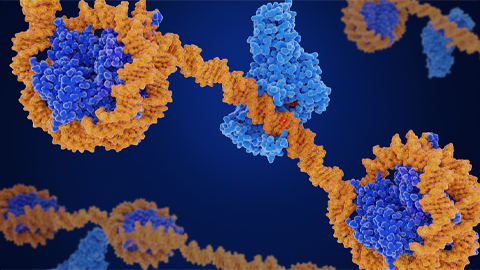
Shining lights on the cell
The cellular machinery is a remarkable system that is able to regulate myriad life processes with exquisite specificity by responding to a variety of environmental cues. This essential regulation is achieved through a network of highly dynamic signaling molecules that are regulated both spatially and temporally.
Inspired by nature’s fluorescent proteins and photosensors, biochemists have made tremendous advances toward developing new classes of genetically encoded protein tools to detect and control signaling activities with high spatiotemporal precision. With these new tools, new kinds of biochemistry, biology and cell biology are being discovered on a regular basis.
For the American Society for Biochemistry and Molecular Biology annual meeting, Discover BMB, in Seattle in March, we have assembled symposia featuring some of the top experts in these diverse fields who will discuss new tools for manipulating and visualizing the activity of enzymes and other classes of protein activity in living cells across a range of settings. As an example of the impact of these tools, we will highlight the emerging field of liquid–liquid phase separation as an organizing principle of cell signaling uniquely identified by advances in our ability to probe and control biomolecules in vitro and in cells.
Keywords: Optogenetics, fluorescent biosensors, protein engineering, phase separation.
Who should attend: Biochemists, cell biologists and protein engineers interested in novel protein-based tools to observe and control cellular behavior as well as new concepts in cellular organization that have emerged from use of these reagents.
Theme song: “Blinding Lights” by The Weeknd.
This session is powered by high-quality photons — from the UV to the infrared.
Speakers
Toolkit for native biochemistry: Sensors, actuators and computational tools
Kevin H. Gardner (chair), City University of New York Advanced Science Research Center
Klaus Hahn, University of North Carolina at Chapel Hill
Sabrina Spencer, University of Colorado Boulder
David van Valen, California Institute of Technology
Spatiotemporal control of cellular signaling
Jin Zhang (chair), University of California, San Diego
Mark von Zastrow, University of California, San Francisco
Lukasz Bugaj, University of Pennsylvania
Anton Bennett, Yale University
Liquid–liquid phase separation as a signaling paradigm
Christine Mayr (chair), Memorial Sloan Kettering Cancer Center
Zhijian "James" Chen, University of Texas Southwestern Medical Center
Sarah Veatch, University of Michigan
Shana Elbaum–Garfinkle, City University of New York Advanced Science Research Center
The complete list
Learn about all 11 symposia planned for Discover BMB 2023:- Protein Machines and Disorder
- Regulation of RNA
- Organelles, Mechanisms and Phase Properties of Cellular Quality Control
- Lipid Dynamics and Signals in Membrane and Protein Structure
- Frontiers in Carbohydrate Synthesis and Recognition
- Bias In, Bias Out in Data Science
- Cell Signaling — New Tools and Emerging Concepts
- Education and Professional Development
- Biochemistry of Elemental Cycling
- Advances in Organismal and Cellular Metabolism
- Artificial Intelligence and Machine Learning in Structural Biology, Drug Design and Systems Biology
Enjoy reading ASBMB Today?
Become a member to receive the print edition four times a year and the digital edition monthly.
Learn moreGet the latest from ASBMB Today
Enter your email address, and we’ll send you a weekly email with recent articles, interviews and more.
Latest in Science
Science highlights or most popular articles

CRISPR epigenome editor offers potential gene therapies
Scientists from the University of California, Berkeley, created a system to modify the methylation patterns in neurons. They presented their findings at ASBMB 2025.

Finding a symphony among complex molecules
MOSAIC scholar Stanna Dorn uses total synthesis to recreate rare bacterial natural products with potential therapeutic applications.

E-cigarettes drive irreversible lung damage via free radicals
E-cigarettes are often thought to be safer because they lack many of the carcinogens found in tobacco cigarettes. However, scientists recently found that exposure to e-cigarette vapor can cause severe, irreversible lung damage.

Using DNA barcodes to capture local biodiversity
Undergraduate at the University of California, Santa Barbara, leads citizen science initiative to engage the public in DNA barcoding to catalog local biodiversity, fostering community involvement in science.

Targeting Toxoplasma parasites and their protein accomplices
Researchers identify that a Toxoplasma gondii enzyme drives parasite's survival. Read more about this recent study from the Journal of Lipid Research.

Scavenger protein receptor aids the transport of lipoproteins
Scientists elucidated how two major splice variants of scavenger receptors affect cellular localization in endothelial cells. Read more about this recent study from the Journal of Lipid Research.


